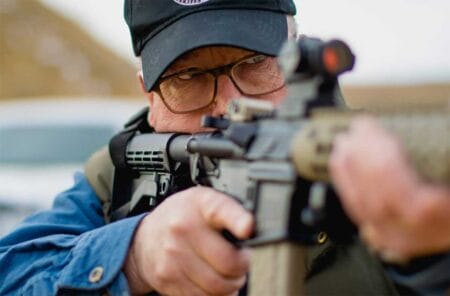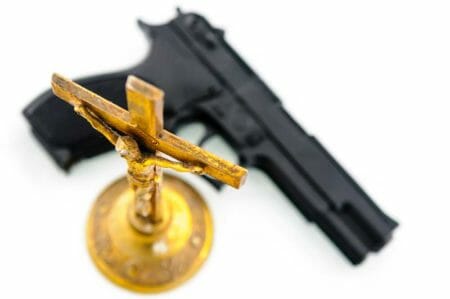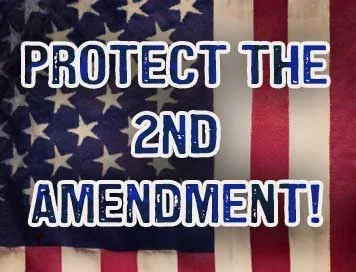The 1911’s Grip Angle – Misses In Close Quarters Battle
By John Veit of Aimed Point Shooting
[We know this article is like poking a stick in a bee hive, but the only way to vet ideas is with vigorous debate…right? 😉 Leave your comments below. – AmmoLand.com]

USA –-(Ammoland.com)- The 1911 Colt automatic pistol caliber-45, was the standard-issue side arm of US Forces for 70 plus years, from 1911 to 1985. And it’s still carried by some military and police members. The 1911 is beloved by gun enthusiasts, and ubiquitous in the world of the gun. However, it has two design faults, and each of them can be fatal for a user.
One is the slide stop pin, which can result in the 1911 jamming when fired. For info on that, see the You Tube video titled: The 1911 – A Fatal Flaw.
The other fault is the 1911’s grip angle which can result in shooting low and missing, even at close quarters.
And that can have fatal consequences for a 1911 user, because if you’re going to be shot or killed, there is an 80 percent chance that it will happen at less than 20 feet.
THE GRIP.
The grip is one of the most important things in combat firing. The pistol should be placed in the crotch of the hand and firmly grasped. The barrel should be in direct alignment with the forearm, so if you pointed your finger instead of the gun, it would be right on target.
“For accurate shooting the gun must be in line with the forearm.”
THE 1911 IS NOT A NATURAL POINTER.
Due to its grip angle, the 1911 is not a natural pointer like a pistol, which when placed in the hand is directly on the target.
When the 1911 is placed in the hand and gripped, the gun muzzle will point down. And because of that, the wrist must be cocked upward to bring the 1911 in line with the target.
WW II soldiers were told that after a little practice, this adjustment will become instinctive.
Now, saying that doesn’t make it so, and in particular in a close quarters situation when someone is trying to kill you.
And you don’t have to be a combat veteran to know that. For example, Sight Shooting has been taught for use for 100 years, but studies of Police combat cases have found that it is seldom used. In combat, Officers default to instinctive shooting of some type.
Another problem with having to cock the wrist upwards, is that with firing, the gun will jump in your hand. So you will have to check the guns alignment before firing again to assure accuracy. And in the extreme stress of close quarters combat that is not likely to happen.
A CRUSH GRIP
According to Applegate, in life or death combat, you will grasp your gun in an almost convulsive grip. In Kill or Get Killed, he said….”in the midst of battle excitement, a man instinctively grips his weapon in this manner and certainly does not take time to hold his breath, line up the sights, and squeeze the trigger.”
And with a crush grip, the middle, ring and little fingers will torgue the gun down and around to the left which will make low shooting worse.
To prevent the low shooting problem, soldiers were taught to hold the arm down and straight, and with the wrist and elbow locked. The shoulder is used as a pivot point to bring the gun up to eye level.
The sights are not used and the gun is fired instinctively, point blank in the general direction of the target.
These pics are from the Fairbairn and Sykes book: Shooting To Live, and show the method they developed based on Police experiences in hundreds of gunfights in China in the early 1900’s.
My concern is that in a self defense situation, it is unlikely that one will have the time and composure to grip the gun correctly, straighten the arm and lock the elbow and wrist, and then bring the stiff arm and gun up under the eye, and then shoot. And then, also have the presence of mind to check and make sure that the grip and locked wrist and arm are the in the same position after the recoil experienced with firing each shot to assure the accuracy of the next shot.
And if the combat area is confined, or filled with obstructions or obstacles, or the action is dynamic, the grip problem could be fatal.
USE YOUR SIGHTS
After writing, and rewriting, and thinking about this article and the subject of CQB shooting, the thought poped into my mind that it is no wonder that the mantras of the “modern shooting schools” have been USE YOUR SIGHTS and FSP, FSP – FRONT SIGHT PRESS.
They tacitly acknowledge the bad grip design, and also that in a high stress situation you will have a crush grip on your gun with the muzzle pointing down. So you must USE YOUR SIGHTS and/or bring the front sight up into view, or you will shoot low and miss.
Unfortunately, unless you are a SEAL or other super highly trained and practiced operator, you will focus on the threat, and your near vision focus will be lost due to the dump of adrenaline into your system which happens automatically and instinctively in a real life threat situation.
You will shoot low and left, unless you know of, and use, an alternate shooting method.
WHY THE ONE HANDED SHOOTING?
Because in a 10 year study by the NYPD of thousands of combat cases, Officers fired with the strong hand with few exceptions.
As to instinctive shooting which is used in gunfights, I favor what I call AIMED Point Shooting or P&S.
With P&S, all you hve to do is grab your gun with your index finger along the side, point your index finger at the target, and pull the trigger with your middle finger. It’s a shooting method that’s been around since at least 1835.
It is brain dead simple, fast, accurate, and deadly effective. And it can be learned and maintained with little or no training.
With your index finger along the side of the gun, it, the barrel and the sights will be in alignment. So you get automatic and correct sight alignment when you grab your gun, and automatic and correct sight placement when you point at a target, and for each shot made.
The grip provides a strong and level shooting platform made up of the natural pincer of thumb and index finger, and with the ring and little fingers adding tenacity to the grip.
With this four fingered grip, front punches and elbow smashes can be made, and the gun and forearm can be used as a crude battle axe. You can squeeze the beegebers out of the gun, and all you will do is add to the strength of the grip.
P&S is not dependant on the marksmanship grip, a stiff arm, or the use of the sights. And it can be used when moving, and against moving targets, even aerials.
Unfortunately, this simple, instinctive, accurate, and deadly method of shooting, which the U.S. Army says works, can not be used with the 1911 because of the design of the 1911’s slide stop as mentioned above.
Visit: www.pointshooting.com







This has to do with the other "fatal flaw" of the 45, not the one mentioned here having to do with the grip. I have seen some pics of the slide stop pin shaved off or the frame counter sunk. Haven't tried a 45 fixed like that, but the flesh of one's finger could still depress it some with firing and that probably could cause the 45 to jam. Looks slick but still jams. I fired a major manufacture's gun with a slide stop similar to the 45's. Had placed a shim on the side of the gun so that… Read more »
The author is full of horse puckey, plain and simple, and makes much ado about something that is a non-issue. His history is incorrect, his facts are false, and generally, seems like another person trying to find reasons to knock on a great pistol. One thing that's pretty bloody laughable: saying that point shooting cannot be used with the 1911 because of the slide stop pin. Apparently the author has never heard of, nor seen, the fairly popular modification to the 1911 pistol design that simply flattens the dimple off of the pin. But, I guess that that would defeat… Read more »
In the pic of the 1911 being held out to show the amount of the gun tip down because of the grip angle, the tip down is ABOUT 10 DEGREES OFF OF HORIZONTAL. In the past I developed a chart that shows how far off the center of a target a bullet will strike, if the gun muzzle is not exactly on the center of the target when the gun is fired. In developing the chart, the muzzle point was considered to be 7 inches out from zero, and by chance each degree of arc equaled about 1/8th inch. Here's… Read more »
Exactly how low does this pistol shoot,mine shoots 2 inches low at 7 yds. Still center mass, were not shooting competition here. I'll take 2 inches low with being centered all day long, so maybe your only getting the bottom of his heart. If you know your gun shoots low, make adjustments or sell it to me, be glad to have it. You do know they sell adjustable sights, lasers etc…
Thats all fine and good fellas, but what about the independent shooter who just picked up his first 1911 and has no formal training on firing it, has not fought with it in a war, does not have a brother, father, sister, uncle who is an experienced 1911 shooter, etc.? They are going to have issues with this. Yes practice is key, but if you continually practice an incorrect technique, you will never improve, and make accurate instinctual shooting nearly impossible.
I have a Springfield Ultra Compact for CCW. I've had, and been shooting, 1911's for more than 30 years. I've never run into this problem with any of them. It's like the previous commenter says: training and practice are the key. That's true of anyone and any gun. As far as the issue with the slide stop pin, I've never run into that problem either. I have had 1911's that don't lock back properly on an empty mag, or that slam into battery when the full mag is seated, but that's a matter of a cheap gun, it's not a… Read more »